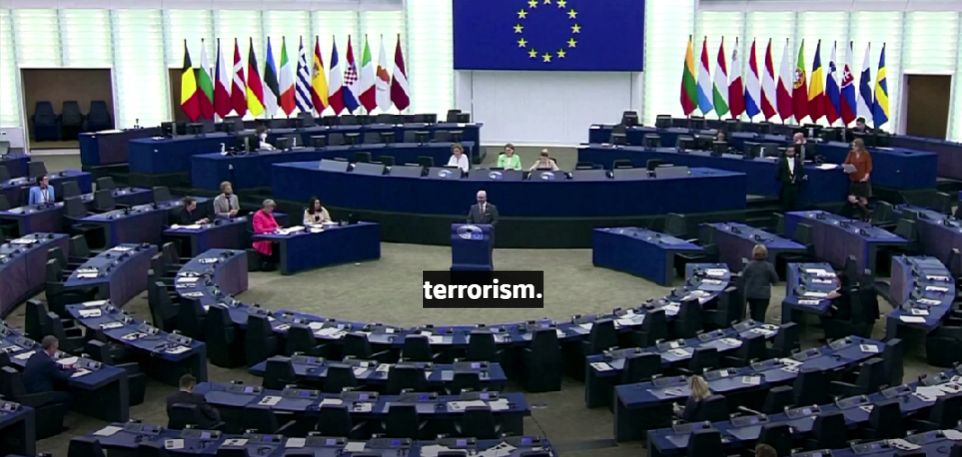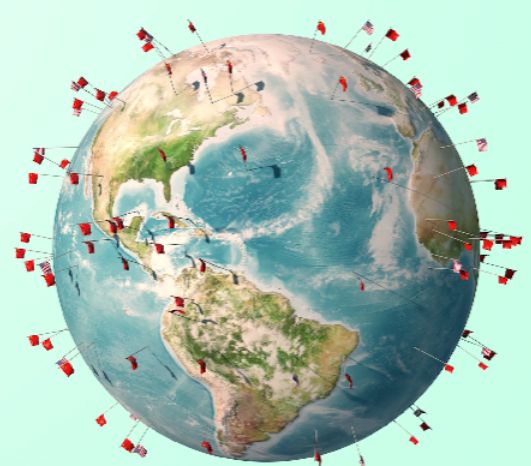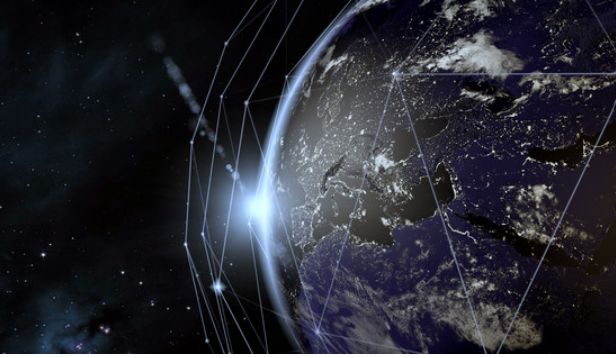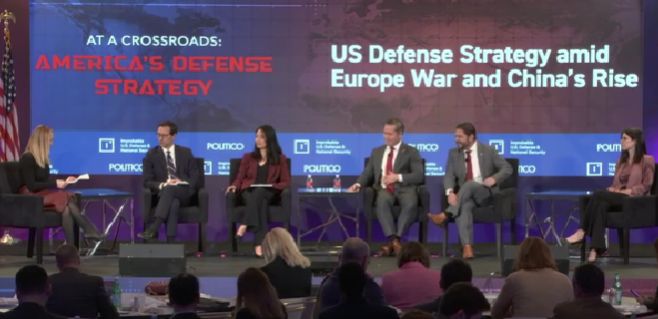By Eric Vandenbroeck
and co-workers
Russia As State Sponsor Of Terrorism
Yesterday the European
Parliament designated Russia a state sponsor of terrorism, arguing that its
military strikes on Ukrainian civilian targets, such as energy infrastructure,
hospitals, schools, and shelters, violated international law.

Tensions between
Russia and the rest of the international community were displayed during a
recent meeting of cybersecurity diplomats in Vienna at the Organization for
Security and Cooperation in Europe. The Russian delegation was barely
tolerated. The frosty situation gives the world even less visibility into
Russian cyber operations at a time when it is launching repeated digital
strikes in Ukraine.
At the same
time, U.S. Senators are alarmed by hundreds of intrusions over the
White House, Capitol, and Pentagon as espionage.

Just 30 years after the
end of the Cold War and 50 years after the U.S. opening to China, the United
States' two principal challengers seem to be on the march and dictating
Washington’s foreign policy decisions. Russia defied many observers’
expectations by invading Ukraine, showing no sign of
relenting nine months into its brutal campaign. Meanwhile, following a
visit to Taiwan by U.S. Speaker of the House Nancy Pelosi in August, China
launched a spate of short-range conventional ballistic missiles—including, for
the first time, over Taiwan—terminated its military dialogue with the United
States and stated that it would conduct regular patrols around Taiwan, raising anxiety that Beijing may soon move on Taipei. Beyond
the pressing concern that the United States could find itself in concurrent
wars with two nuclear-armed powers, U.S. officials have a broader
fear: that the global balance of power could be at a troubling inflection
point. In the national
security strategy released
last month, the Biden administration warns that the “terms of geopolitical
competition between the major powers will be set” over the coming decade. The
administration is most concerned about “powers that layer authoritarian
governance with a revisionist foreign policy,” particularly Russia and China.
Against this
foreboding geopolitical backdrop, it may seem incongruous to venture that
Washington has an opportunity to steady its long-term outlook. The key to
seizing this chance lies in a counterintuitive conclusion: although Moscow and
Beijing are formidable challengers, they are increasingly self-limiting. With
its aggression against Ukraine, Russia has undercut its economic prospects,
depleted its military assets, and strengthened the transatlantic project. The
Chinese government, meanwhile, is tightening its grip on the private sector,
provoking counterbalancing in Asia, and inducing greater diplomatic coordination
in the West. If the United States’ initial mistake after the Cold War was to
underreact Russia and China, it must now avoid the opposite error.
Self-Inflicted Harm
Russia has offered a
brutal corrective to observers who once dismissed it or even still do. Its
invasion of Ukraine has destabilized energy markets, exacerbated food
insecurity, and imperiled an already fragile global economic recovery from the
COVID-19 pandemic. The more pronounced those consequences become, the harder it
will be to sustain a unified response to Moscow’s aggression. Although Russia’s
relationships with the West will remain irreparable so long as Vladimir Putin
is president, Moscow has not been consigned to pariah status. Instead, most countries—including
economic powerhouses China, India, and Brazil—have declined to sanction it for
its invasion, and the value of Russia’s exports has increased since the war
began. Russia’s growing partnership with Saudi Arabia demonstrates that
isolation from the West does not mean global ostracization.
But in affirming that
it is an enduring power that can cause global upheaval, Russia has undercut
itself economically, militarily, and diplomatically. While Russia has been
able to blunt the effect of sanctions by imposing strict capital controls and
taking advantage of high energy prices, Pierre-Olivier Gourinchas,
the International Monetary Fund’s chief economist, noted in July that the sanctions’ impact would deepen
over time, steadily curtailing Russia’s access to capital and technology. And
by compelling Europe to find alternatives to Russian oil and gas on an
accelerated timeline, Moscow has dramatically weakened its energy leverage over
the long term. The continent is bracing for brutal winters this year and next,
but Europe’s adjustment pains will not derail its energy diversification.
Russia will also
struggle to rebuild its military power. Putin’s September order to
mobilize Russian conscripts demonstrates how significant its personnel and
material losses have been and how markedly momentum on the battlefield has
shifted in Ukraine’s favor. In addition to using decades-old equipment to
sustain its campaign, Russia is turning to Syria and Iran for military
assistance. The Royal United Services Institute, a London-based think tank
focusing on security, found that 27 of Russia’s critical military systems
rely heavily on some 450 microelectronic components made in the United States,
Europe, and Asia. Maintaining those systems and the defense industrial base
that underpins them will grow more difficult and costly as sanctions restrict
Moscow’s ability to procure semiconductors.
However, Russia’s
most challenging task will be to repair the diplomatic damage it has sustained.
NATO is poised to admit Finland and Sweden, the E.U. has granted membership
candidate status to Ukraine and Moldova, and even Central Asian countries that
Russia presumes to be within its sphere of influence are reconsidering their
orientations. Further afield, Japan and South Korea have both imposed sanctions
against Russia, and India has redoubled its efforts to find substitutes for
Russian energy and arms. Even China, Russia’s putative “no limits” partner, may
be looking to modify its relationship. Chinese President Xi Jinping hinted at
that possibility at the Shanghai Cooperation Organization summit in September
when he informed Putin of his “questions and concerns” about Russia’s war.

Closer to home, China
is eroding the United States’ military overmatch in Asia and increasing its
centrality within the global economy (its GDP is forecast to be roughly 87 percent as large as the United
States in 2027). It also uses geoeconomic statecraft and technological
innovation to build its global influence. It, too, however, confronts severe
economic, military, and diplomatic challenges.
A poor demographic
trajectory, an economic model that faces diminishing returns, and a fixation on
consolidating the Chinese Communist Party’s rule are all hampering China’s prospects
for maintaining robust growth. And external headwinds could amplify internal
ones. The economic woes of the Belt and Road Initiative are mounting as the
pandemic, and Russia’s invasion of Ukraine make it even harder for many
recipient countries to pay back loans that they have received from Chinese
institutions to finance infrastructure projects. As it renegotiates a growing
value of overseas loans—$52 billion in 2020 and 2021, up from $16 billion in
2018 and 2019—China has also offered “rescue loans” to countries including
Argentina, Egypt, Nigeria, Sri Lanka, and Turkey to help them avoid
balance-of-payments crises.
As China seeks to
place its economy on a stabler footing, it must also contend with a more
challenging security landscape. The leaders of Australia, India, Japan, and the
United States—the members of the Quadrilateral Security
Dialogue, known as the Quad—have now convened four times, first in March 2021
and most recently in May of this year. Canberra has significantly reviewed its
defense posture to enhance its long-range strike capabilities and modernize its
navy. Washington and New Delhi have pledged to improve their interoperability
“across all domains of potential conflict,” inked an agreement to
facilitate cooperation in space, and committed to new talks on artificial
intelligence. And owing in part to shared anxiety over China’s deepening
ties to Russia, Tokyo and Seoul are moving incrementally to build mutual trust.
Finally, and critically, the United States, Australia, India, Japan, and South
Korea are all significantly increasing their defense spending.
Like Russia, China
will find that its most significant challenge is diplomacy. Washington is convinced
that Beijing seeks to become the world’s preeminent power, and bipartisan
support for strengthening ties between the United States and Taiwan is growing.
The E.U. is steadily adjusting its stance toward China, as seen with its
decision to pause the ratification of the Comprehensive Agreement on
Investment, a deal seven years in the making that was intended to improve both
European investors’ access to and European companies’ treatment in China’s vast
consumer market. China’s failure to condemn Russian aggression in Ukraine has
only deepened Europe’s anxiety—as well as that of NATO, which
warns in its new
strategic concept that
China’s “stated ambitions and coercive policies challenge our interests,
security, and values.” And the Quad proceeds with clear momentum, has
intensified efforts to articulate standards in critical technology domains such
as artificial intelligence and quantum computing, launched the Indo-Pacific
Partnership for Maritime Domain Awareness, and announced a Climate Change
Adaptation and Mitigation Package.
Beijing is far more
capable of offsetting external pressure than Moscow by deepening its
relationships across the developing world. Even so, it has needlessly alienated
advanced industrial democracies, calling into question its much-vaunted
strategic acumen.
The Risk Of Overreaction
The United States
could not become complacent in response to Russia and China’s competitive
missteps, but it must now guard against overreacting and contesting those two
countries ubiquitously. At first glance, recent history would seem to furnish
an obvious rejoinder to such caution: the United States waged and won a nearly
half-century-long global struggle against the Soviet Union. As the Cold War
progressed, psychological considerations increasingly supplanted material
realities in driving U.S. foreign policy: fearing that any Soviet inroads that
went unanswered could presage a systemic erosion of the United States'
competitive perch, Washington contested Moscow in countries as disparate as
Angola, Lebanon, and Nicaragua. But the United States faced an economically
outmatched competitor during the Cold War: the Soviet Union’s economy was
always less than half as large as its own.
Today, while the
United States remains the world’s foremost power, it is in relative decline.
Its share of global GDP decreased from roughly 30 percent in 2000 to just under
25 percent in 2020. In addition, its share of global goods exports diminished
from approximately 12 percent to just over 8 percent during that period. And
the percentage of global foreign exchange reserves denominated in U.S.
dollars fell to its lowest level in a quarter-century in
2020. Meanwhile, China’s economy is already about three-quarters as
large as the United States, its exports reached a record high of
$3.36 trillion last year, and the available evidence suggests that the rhetoric decoupling China from the
global economy outstrips the reality. Today’s geopolitical environment would
accordingly be less forgiving of the indiscipline that Washington once
exhibited. Although Russia and China are manageable by being self-limiting,
they collectively have ample capacity to goad the United States and lock it
into a reactive and self-defeating foreign policy.

There are other
reasons why the United States could choose selective competition over universal
struggle. Not every decision Russia or China makes is intrinsically inimical to
vital U.S. national interests—or necessarily taken with the United States in
mind. Despite narratives that still suffuse much American commentary—portraying
Russia as the stealthy and ubiquitous opportunist and China as the patient and
farsighted strategist—neither is immune to hubris and overstretch. And although
an inexorably tightening China-Russia entente may seem like a fait accompli,
U.S. foreign policy could entertain the possibility that strains between the
two countries could eventually emerge. Moreover, Washington’s efforts to manage
transnational challenges, such as climate change and future pandemics, will be
limited if the United States bypasses Russia and China and solely engages
like-minded countries.
Finally, beyond
achieving little traction in the developing world, a foreign policy organized
too tightly around contesting Russia and China would elicit significant concern
even among U.S. allies and partners, few of which would take kindly to serving
as instruments of a new Cold War—an outcome, President Joe Biden has often and
properly stressed, that need not be inevitable. Perhaps the most crucial
observation in the administration’s national security strategy reflects that
judgment: “We will avoid the temptation to see the world solely through the
prism of strategic competition and will continue to engage countries on their
terms.”
A Disciplined Approach
Maintaining
competitive equanimity is difficult for every power. Still, it is hardest for
the world’s sole superpower—especially because the United States' principal
challengers contest the vision of international order that many
U.S. officials and scholars had thought to be triumphant just three decades
earlier. The traction that “great-power competition” has achieved in the U.S.
policymaking community reflects that anxiety.

Paradoxically,
however, the widespread resonance of that framework—essentially transcending
ideological divides—also reflects a sense of bureaucratic comfort. From the
late 1930s to the 1980s, the United States primarily oriented its foreign
policy around three external challengers: imperial Japan, Nazi Germany, and the
Soviet Union. The end of the Cold War proved a pyrrhic victory for Washington,
for the existence of the Soviet threat, had helped to define its role in the
world for nearly 50 years. For roughly a quarter-century afterward, the United
States struggled to settle on an anchoring construct, variously experimenting
with “engagement and enlargement,” “the global war on terrorism,” and “the
pivot to Asia.” A revanchist Moscow and a resurgent Beijing would seem to
permit Washington to return to a familiar playbook, restoring clarity to U.S.
foreign policy and maybe even cultivating greater cohesion among a divided
American public.
But such hopes are
questionable. Japan and Germany were defeated militarily during World War II.
Today, however, because of the possibility that a great-power war with Russia or
China could escalate to the nuclear level, the United States has a vital
national interest in avoiding such a confrontation. And although Moscow and
Beijing both confront numerous socioeconomic challenges, neither seems poised
for a Soviet-style collapse. In addition, while even limited great-power
cooperation might seem inconceivable, transnational challenges will continue to
entangle the society and economy of the United States with those of Russia and
China—no matter how vigorously Washington and its competitors attempt to
decouple from one another. Finally, although competitive anxiety can spur
internal renewal, the United States could neither use it as a crutch nor assume
that great-power competition will ease political polarization at home.
In other words, the
United States should consider not how it can achieve an illusory triumph over
its competitors but how it can sustain an uncomfortable cohabitation with them.
That there is no ready blueprint for navigating this ambiguity means that Washington
should develop a substantially new plan even as it continues to mine its
history for guidance.
Managing great-power
frictions will remain a core component of foreign policy because the stakes of
avoiding armed confrontations with Russia and China are so high. Beyond taking
steps in the service of that imperative, the United States could continue
working with its allies and partners to enhance democratic resilience against
supply chain disruptions and economic coercion, shape next-generation technology
standards, support the global South’s economic development, and build new
coalitions to address transnational challenges—partnering with Russia and China
where possible.
Even as it embraces
selective competition, the United States risks getting drawn into a global
struggle with Russia and China. Going down that path would compel those two
countries to draw even closer together than they would have otherwise and limit
the U.S.’s ability to make diplomatic inroads in regions such as Latin America,
Southeast Asia, and sub-Saharan Africa. Washington could instead make a
decisive break with the inertia that for some eight decades has tethered its
foreign policy to the actions of—and, at times, the search for—external
competitors. It could accord top priority to renewing its unique competitive
advantages, demonstrating anew that it has an enduring capacity to strengthen
its socioeconomic foundations at home and mobilize collective action abroad to
meet the full array of planetary challenges.
Moscow and Beijing are
formidable challengers. The good news is that their missteps allow others to
pursue a foreign policy rooted less in answering their every maneuver than
articulating its aspirations.
For updates click hompage here